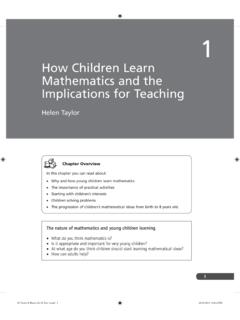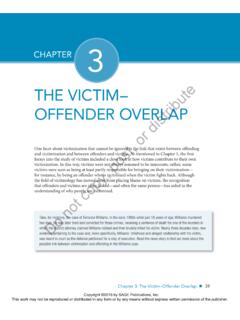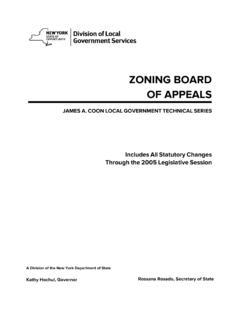Transcription of Juvenile Justice Policies and Programs - SAGE Publications Inc
1 C H A P T E R 9. e ut Juvenile Justice rib Policies and Programs t is William H. Barton d or T he knowledge, events, and values specific to any given point in time exert a profound t, influence on Juvenile Justice policy and practices. After decades of getting tough with young offenders and flirting with the treatment model du jour, the Juvenile Justice system s now finds itself at a policy and programmatic crossroad. Recent advances in theory, po research, and practice based on principles of risk, protection, and resilience hold promise for a more rational, comprehensive set of Juvenile Justice Policies and practices. Nevertheless, such optimism must be tempered by the inevitable role played by societal values, politics, and public perceptions and by limitations in the knowledge base itself. , This chapter provides an outline of this conceptual advance in Juvenile Justice policy, py places it in a historical context, and suggests ways it can be used to improve current and future Policies and practices.
2 The first section presents an overview of the goals and stake- holders involved in Juvenile Justice policy. The second section reviews current patterns of co delinquency prevalence and incidence. The third section outlines the risk and protective factors associated with delinquent behavior. The fourth section traces the history of juve- nile Justice Policies , noting the extent to which presumed risk and protective factors have exerted an influence. The final section applies what we have learned about risk, protection, t and resilience to Juvenile Justice Policies and practices and concludes that this knowledge no base can provide a foundation for more effective and efficient ways to address delinquency through the promotion of positive youth development. o PURPOSE AND OVERVIEW OF Juvenile Justice POLICY.
3 D. Prior to the 20th century, the United States did not have a Juvenile Justice policy per se. Although age was considered a factor in mitigating punishment, the adult court had jurisdiction over children who committed crimes. The first Juvenile court was established in Chicago in 1899, and by 1925, all but two states had followed suit (Bernard &. 256. Copyright 2016 by SAGE Publications , Inc. This work may not be reproduced or distributed in any form or by any means without express written permission of the publisher. CHAPTER 9 Juvenile Justice Policies and Programs 257. Kurlychek, 2010). The Juvenile court was the expression of the first formal Juvenile Justice policy, which held that juveniles were distinct from adults and that the system should act in the best interests of the child. Specialized Juvenile probation services emerged to monitor juveniles who were under the jurisdiction of the court (National e Center for Juvenile Justice , 1991).
4 This two-tiered court system created a tension between the goals of rehabilitation ut and punishment that continues to this day. As described later in this chapter, the parade of policy reforms since the founding of the Juvenile court has reflected alternating rib emphases on these two primary goals. Historically, relatively lenient Policies favoring treatment have alternated with get tough Policies mandating punishment. Table summarizes events that have shaped Juvenile Justice policy since the founding of the t first Juvenile court. d is Table Chronology of Events Affecting Juvenile Justice Policy or Date Event Comments <1899 Children treated the same as adults under the law 1899. Cook County, Illinois s t, First Juvenile court established in Parents patriae philosophy Juvenile court was to act in the best interests of the child 1900 1950 All states establish Juvenile courts po 1960s 1980s Interest in delinquency prevention, Community organization approaches ( , diversion, and Mobilization for Youth), diversion, and deinstitutionalization Programs deinstitutionalization are implemented (see 1974.)
5 JJDPA below). , py 1966 Kent v. United States Courts must provide the essentials of due process . in transferring juveniles to the adult system 1967 In re Gault In hearings that could result in commitment to an co institution, juveniles have four basic constitutional rights (notice, counsel, questioning witnesses, protection against self-incrimination). t 1968 Juvenile Delinquency Prevention Children charged with status offenses were to be no and Control Act handled outside the court system 1970 In re Winship In delinquency matters, the state must prove its case beyond a reasonable doubt 1971 McKeiver v. Pennsylvania Jury trials are not constitutionally required in o Juvenile court hearings D. 1974 Juvenile Justice and Delinquency Deinstitutionalization of status offenders; separation Prevention Act (JJDPA) of Juvenile and adult offenders (Continued).
6 Copyright 2016 by SAGE Publications , Inc. This work may not be reproduced or distributed in any form or by any means without express written permission of the publisher. 258 SOCIAL POLICY FOR CHILDREN AND FAMILIES. Table (Continued). Date Event Comments e 1975 Lipton, Martinson, & Wilks report Results misinterpreted by most as indicating that ut nothing works in Juvenile corrections 1975 Breed v. Jones Waiver to criminal court following adjudication in rib Juvenile court constitutes double jeopardy 1977 1979 Oklahoma Publishing Co. v. District The press may report Juvenile court proceedings Court/Smith v. Daily Mail under certain circumstances t 1980 Amendment to the JJDPA Juveniles removed from adult jails and lockups is 1982 Eddings v. Oklahoma Reversed the death sentence of a 16-year-old tried in adult court; ruled that a defendant's young age d should be considered a mitigating factor 1984 Schall v.
7 Martin Preventive pretrial detention of juveniles is or allowable under certain circumstances 1988 Maloney, Romig, & Armstrong Some Juvenile Justice jurisdictions adopt the three introduce the balanced approach goals of public safety protection, accountability, and t, competency development s 1988 Thompson v. Oklahoma Ruled that the Eighth Amendment prohibits the death penalty for persons younger than 16 years old po 1989 Stanford v. Kentucky Ruled that the Eighth Amendment does not prohibit the death penalty for persons who committed capital crimes when 16 or 17 years old , 1980s 1990s Several highly publicized violent More juveniles are transferred to the adult system;. py acts by juveniles; states toughen many states adopt mandatory sentences; Juvenile Juvenile codes court confidentiality provisions are weakened.
8 Special Programs target serious Juvenile offenders;. co Scared-Straight and boot camp Programs proliferate 1990s Many states adopt blended Extends sanctions beyond upper age of Juvenile sentencing Policies court jurisdiction; creates a middle ground between t Juvenile and adult sanctions no 1990s Many schools adopt zero- More youths excluded from school; often end up in tolerance Policies the Juvenile Justice system 1993 Office of Juvenile Justice and Approach favors prevention, risk assessment and o Delinquency Prevention (OJJDP) classification, and adoption of evidence-based introduces its comprehensive treatment Programs ; adopted by several states D. strategy . 1995 OJJDP launches balanced & Restorative Justice philosophy begins to appear in restorative Justice project some jurisdictions ( , victim offender mediation, family group conferences, teen courts).
9 Copyright 2016 by SAGE Publications , Inc. This work may not be reproduced or distributed in any form or by any means without express written permission of the publisher. CHAPTER 9 Juvenile Justice Policies and Programs 259. Date Event Comments 1995 2010 The rate of Juvenile crime declines; Despite Juvenile crime reductions, formal court Annie E. Casey Foundation's processing continues to increase and get tough . Juvenile Detention Alternatives Policies remain; use of secure detention and post- e Initiative spreads; What Works adjudication incarceration decrease slightly; some ut initiative is marketed to jurisdictions adopt evidence-based interventions jurisdictions to encourage use of evidence-based interventions;. rib major federal re-entry initiatives launched (Serious and Violent Offender Re-entry Initiative).
10 T 2005 Roper v. Simmons Supreme Court ruled that the Eighth is Amendment prohibits imposing the death penalty on all juveniles under the age of 18. d 2010 2012 Graham v. Florida; Miller v. Alabama; Supreme Court ruled that the Eighth Jackson v. Hobbs Amendment does not allow a Juvenile offender to be or sentenced to life in prison without parole for a non- homicide offense 2011 2014 The rate of Juvenile crime remains t, These reports represent the culmination of the low. The National Research Council incorporation of concepts of risk, resilience, and of the National Academy of developmental science into Juvenile Justice . While s Sciences issues a major report vestiges of the get tough Policies remain, many po calling for a developmental jurisdictions are changing their approaches as a approach to Juvenile Justice .












